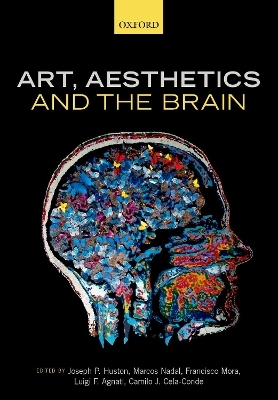
Art, Aesthetics, and the Brain
Oxford University Press (Verlag)
978-0-19-882523-4 (ISBN)
Humans have engaged in artistic and aesthetic activities since the appearance of our species. Our ancestors have decorated their bodies, tools, and utensils for over 100,000 years. The expression of meaning using color, line, sound, rhythm, or movement, among other means, constitutes a fundamental aspect of our species' biological and cultural heritage. Art and aesthetics, therefore, contribute to our species identity and distinguish it from its living and extinct relatives.
Science is faced with the challenge of explaining the natural foundations of such a unique trait, and the way cultural processes nurture it into magnificent expressions, historically and ethnically unique. How does the human brain bring about these sorts of behaviors? What neural processes underlie the appreciation of painting, music, and dance? How does training modulate these processes? How are they impaired by brain lesions and neurodegenerative diseases? How did such neural underpinnings evolve? Are humans the only species capable of aesthetic appreciation, or are other species endowed with the rudiments of this capacity?
This volume brings together the work on such questions by leading experts in genetics, psychology, neuroimaging, neuropsychology, art history, and philosophy. It sets the stage for a cognitive neuroscience of art and aesthetics, understood in the broadest possible terms. With sections on visual art, dance, music, neuropsychology, and evolution, the breadth of this volume's scope reflects the richness and variety of topics and methods currently used today by scientists to understand the way our brain endows us with the faculty to produce and appreciate art and aesthetics.
Joseph P. Huston is Professor of Physiological Psychology at the University of Düsseldorf, Germany. Joseph has published more than 400 books and scientific articles in areas of behavioral neurosciences with a focus on brain mechanisms of addiction, memory, and reward. He is chief editor of the journals Behavioural Brain Research and Reviews in the Neurosciences, and the book series Handbook of Behavioral Neuroscience. Marcos Nadal is Assistant Professor at the Department of Psychology of the University of the Balearic Islands, Spain. His main research focuses on the evolution, neural correlates, and function of cognitive and affective processes involved in aesthetic preference and art appreciation, as well as moral judgment and metaphoric language. Francisco Mora is Professor of Human Physiology at the Faculty of Medicine, University Complutense of Madrid, Spain. He has written numerous articles for scientific journals including Science and Nature and several books, among them The Hot Brain and Neurocultura. Luigi F. Agnati is Professor of Human Physiology at the University of Modena, Italy, and Adjunct Professor at the Karolinska Institutet, Sweden, where he received the Honoris Causa Degree in Medicine. He has published more than 620 papers in refereed international journals and seven textbooks. Camilo J. Cela-Conde is Emeritus Professor of the University of the Balearic Islands, Spain. His publications include On Genes, Gods and Tyrants, Human Evolution:Trails from the Past (with Francisco J. Ayala) and Processes in Human Evolution: The Journey from Early Hominins to Neandertals and Modern Humans (with Francisco J. Ayala).
Section One: Foundational Issues
1: Francisco Mora: Neuroculture: A new cultural revolution?
2: William P. Seeley: Art, meaning, and aesthetics: the case for a cognitive neuroscience of art
3: Kirill Fayn and Paul J. Silvia: States, People, and Contexts: Three Psychological Challenges for the Neuroscience of Aesthetics
4: Helmut Leder, Gernot Gerger and David Brieber: Aesthetic appreciation - convergence from experimental aesthetics and physiology
5: Christoph Klein and Raphael Rosenberg: The Moving Eye of the Beholder. Eye-Tracking and the Perception of Paintings
Section Two: Cognitive Neuroscience of Visual Aesthetics and Art
6: Spas Getov and Joel S. Winston: Neural Mechanisms for Evaluating the Attractiveness of Faces
7: Robert Pepperell and Alumit Ishai: Indeterminate Art Works and the Human Brain
8: Ulrich Kirk and David Freedberg: Contextual bias and insulation against bias during esthetic rating: the implication of VMPFC and DLPFC in neural valuation
9: Oshin Vartanian: Neuroimaging Studies of Making Aesthetic Products
Section Three: Cognitive Neuroscience of Dance
10: Emily S. Cross: Beautiful embodiment: The shaping of aesthetic preference by personal experience
11: Beatriz Calvo-Merino: Sensorimotor aesthetics: Neural correlates of aesthetic perception of dance
12: Julia F. Christensen and Corinne Jola: Moving towards ecological validity in empirical aesthetics
Section Four: Cognitive Neuroscience of Music
13: Kathleen A. Corrigall and E. Glenn Schellenberg: Liking music: Genres, contextual factors, and individual differences
14: Moritz Lehne and Stefan Koelsch: Tension-resolution patterns as a key element of aesthetic experience: psychological principles and underlying brain mechanisms
15: Elvira Brattico: From Pleasure to Liking and Back: Bottom-up and Top-down Neural Routes to the Aesthetic Enjoyment of Music
16: Marcus T. Pearce: Effects of expertise on the cognitive and neural processes involved in musical appreciation
Section Five: Neuropsychology of Art and Aesthetics
17: Anjan Chatterjee: The Neuropsychology of Visual Art
18: Indre Viskontas and Suzee Lee: The Creation of Art in the Setting of Dementia
19: Dahlia W. Zaidel: Hemispheric Specialization, Art, and Aesthetics
Section Six: The Evolution of Art, Aesthetics, and the Brain
20: Gesche Westphal-Fitch and W. Tecumseh Fitch: Towards a comparative approach to empirical aesthetics
21: Camilo J. Cela-Conde and Francisco Ayala: Art and Brain Coevolution
22: Luigi F. Agnati, Diego Guidolin, and Kjell Fuxe: Art as a human "instinct-like " behaviour emerging from the exaptation of the communication processes
Section Seven: Integrative Approaches
23: Edmund T. Rolls: Neurobiological foundations of art and aesthetics
24: Alexander J. Huston and Joseph P. Huston: Aesthetic evaluation of art: a formal approach
25: Barbara G. Goodrich: Tempos of Eternity: Music, Volition, and Playing with Time
| Erscheinungsdatum | 18.12.2018 |
|---|---|
| Verlagsort | Oxford |
| Sprache | englisch |
| Maße | 174 x 247 mm |
| Gewicht | 1104 g |
| Themenwelt | Kunst / Musik / Theater ► Allgemeines / Lexika |
| Geisteswissenschaften ► Philosophie | |
| Geisteswissenschaften ► Psychologie ► Allgemeine Psychologie | |
| Geisteswissenschaften ► Psychologie ► Verhaltenstherapie | |
| ISBN-10 | 0-19-882523-4 / 0198825234 |
| ISBN-13 | 978-0-19-882523-4 / 9780198825234 |
| Zustand | Neuware |
| Haben Sie eine Frage zum Produkt? |
aus dem Bereich


